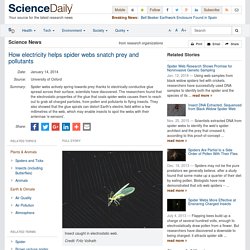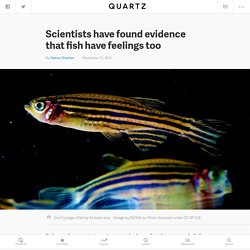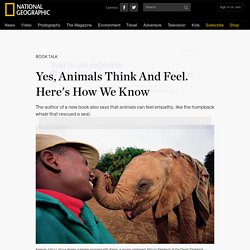

Mother Dolphins Sing To Their Babies In The Womb. The intelligence of dolphins never fails to amaze us less-flippered friends – and we’re not just talking about the dolphin that stole a woman’s iPad this week.

New research has shown that dolphins “sing” to their unborn calves in their womb. Dolphins use “signature whistles” to identify and communicate with one another, much like we use names. Mother dolphins have been observed performing a signature whistle for the baby in the months running up to the birth and up to two weeks after. This has been studied before, but this new research looked into the rates of these whistles and if they changed after the birth. Audra Ames, of the Marine Mammal Behavior and Cognition Lab at the University of Southern Mississippi, showed some of their findings at the annual American Psychological Association conference, Live Science reports.
How electricity helps spider webs snatch prey and pollutants. Spider webs actively spring towards prey thanks to electrically-conductive glue spread across their surface, Oxford University scientists have discovered.

The researchers found that the electrostatic properties of the glue that coats spider webs causes them to reach out to grab all charged particles, from pollen and pollutants to flying insects. They also showed that the glue spirals can distort Earth's electric field within a few millimetres of the web, which may enable insects to spot the webs with their antennae 'e-sensors'.
The study, published in Naturwissenschaften, shows how a quirk of physics causes webs to move towards all airborne objects, regardless of whether they are positively or negatively charged. Scientists have found evidence that fish have feelings too. Shanghai’s seventh annual “Love and Marriage Expo” was held this year in Aima Palace, in the northeastern suburb of Baoshan—the district I live in.

The palace and surrounding park were designed to hold Western-style wedding ceremonies, but on Oct. 31 over 4,000 single people under 40 were amassed there, looking for their other halves. As a 23-year-old only child from a working-class family from Shanghai, I am in no rush to find a girlfriend. But marriage at a young age in China is considered the norm right now. My parents certainly think it should be. Since I got a job, they’ve now and then asked me euphemistically, “Do you have a direction?” My mother didn’t force me to go to the matchup event. Name: Mr. Yes, Animals Think And Feel. Here's How We Know. Do animals feel empathy?

Does an elephant have consciousness? Can a dog plan ahead? These are some of the questions that award-winning environmental writer Carl Safina teases out in his new book, Beyond Words: How Animals Think and Feel. Ranging far and wide across the world, from the Ambroseli National Park in Kenya to the Pacific Northwest, he shows us why it is important to acknowledge consciousness in animals and how exciting new discoveries about the brain are breaking down barriers between us and other non-human animals. Speaking from Stony Brook University on Long Island, New York, where he is a visiting professor in the school of journalism, he explains how elephants routinely display empathy; why U.S. Gli scimpanzé sanno di non sapere. Elephants distinguish age, gender, and ethnicity in human voices.
Last week, we learned how elephants have a call that means “HUMAN”, used to alert other elephants to potential danger.

This week, scientists reveal that elephants seem to know which humans might pose an actual threat: they can actually distinguish between humans’ age, gender, and ethnicity from just acoustic cues. Free-ranging elephants often encounter the cattle-herding Maasai people, who are semi-nomadic and sometimes kill elephants over conflicts over water or land for grazing. In a previous study, the scent of red robes worn by a Maasai man provoked a fearful response in elephants. To further tease this out, a team led by Karen McComb and Graeme Shannon from the University of Sussex recorded Maasai men, women, and boys, along with men of the nearby, crop-farming Kamba people.
Chimpanzees Are Over-Hunting Their Prey To Local Extinction. Chimpanzees have almost hunted one of their prey – the red colobus monkey – to local extinction.

The population size of the red colobus monkey has dropped dramatically, by 89% between 1975 and 2007. Since decimating the red colobus monkey population, chimpanzees are turning to new prey, and reducing their population size too. Some non-human primates (NHPs) hunt other NHPs as prey. The chimpanzees and red colobus monkeys are a classic example. In the forest in Kibale National Park, Uganda, chimpanzees prey heavily on red colobus monkeys. Military Explosions Caused Mass Whale Stranding. Four years ago on the north coast of Scotland, 39 long-finned pilot whales stranded themselves as the tide was going out.

Rescue teams managed to save just over half of the cetaceans, but what caused this mass stranding event has been the center of speculation ever since. Most attention has, however, been focused on the Royal Navy testing ground located in the area. Now, a long-awaited report conducted by British governmental scientists has been released, in which the authors finally reach a conclusion over what caused the stranding event.